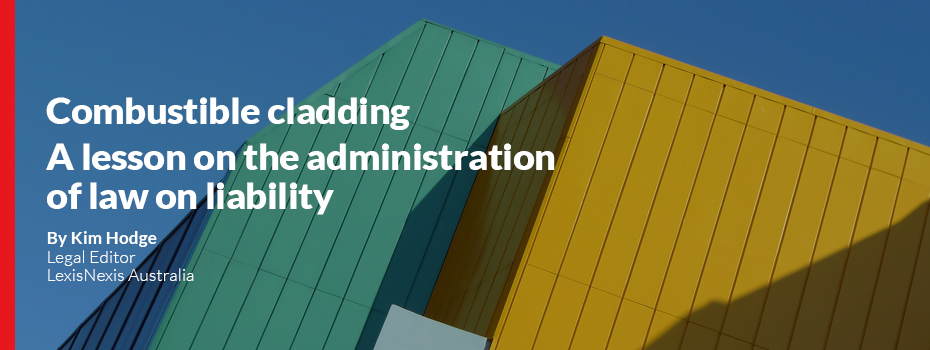
Combustible Cladding: A lesson on the administration of law on liability
18 November 2021 18:01
The fires at the Grenfell Tower in London in 2017 and the Lacrosse building in Melbourne in 2014 have resulted in new laws for buildings with external combustible cladding. New South Wales has experienced issues with defective buildings at Erskineville, Mascot and Sydney Olympic Park.
There have been various approaches to dealing with these issues in different state jurisdictions.
New South Wales
The State Government of New South Wales amended the law to deal with combustible cladding. It amended the Environmental Planning and Assessment Regulation 2000 (NSW) (Regulation) with amendments contained in the Environmental Planning and Assessment Amendment (Identification of Buildings with External Combustible Cladding) Regulation 2018 (NSW) and introduced the State Environmental Planning Policy Amendment (Exempt Development—Cladding and Decorative Work) 2018 (NSW). The changes pursuant to these statutory instruments commenced on 22 October 2018.
Under the Regulation, owners of certain buildings with external combustible cladding are required to register their building with the New South Wales Government through the New South Wales cladding registration portal.
For buildings occupied before 22 October 2018, the deadline for registration was 22 February 2019. Owners of new buildings are required to register their building within 4 months of the building first being occupied.
The New South Wales Government also amended eight State Environmental Planning Policies concerning the approval process for new cladding, re-cladding and decorative work on buildings and also introduced the Strata Building Bond and Inspection Scheme (the Scheme) on 1 January 2018 as a way to rectify defective building work in new high-rise strata buildings.
Under the Scheme developers are required to lodge a building bond with NSW Fair Trading for residential and mixed-use high-rise strata buildings of four storeys and over. Buildings that are three storeys or under may be covered under home building compensation cover. There is an online portal for lodgement and inspections.
Queensland
Amendments to the Queensland Building and Construction Commission Act 1991(Qld) (QBCCA) which commenced on 1 November 2017 have made it an offence for any person involved with the design, manufacture, import or supply of a building product to install a product when it “knows, or ought reasonably to know” that the product does not comply with the relevant regulatory provisions. Combustible cladding is noncompliant and would breach the QBCCA amendments. An available remedy is that the offending party rectify the contravention of the QBCCA (ie, remove and replace the cladding).
Victoria
The Building Amendment (Registration of Building Trades and Other Matters) Bill 2018 (Vic) introduced the following measures to deal with dangerous combustible building cladding:
- Amendments to the Building Act 1993 (Vic) grant the Minister for Planning the power to prohibit the use of high-risk cladding products (defined as “high risk external wall cladding product”) if they present a serious risk to human life or property.
- Amendments to the Local Government Act 1989 (Vic) introduced Pt 8B being “cladding rectification agreements” which may be entered into between councils, owners or owners corporations, lenders and others to facilitate access to affordable loans for owners or owners corporations to finance the rectification of noncompliant cladding.
In 2020, the Building Amendment (Cladding Rectification) Act 2019 came into effect, which conferred further functions on the Victorian Building Authority in relation to cladding rectification and provided for financial assistance for building work associated with cladding rectification.
Defective buildings and cladding: a snapshot of regulatory approaches to the problem (2019) 34(9) APLB 138
The “Lacrosse” decision
In 2019, the long-awaited decision in Owners Corporation No 1 of PS613436T v LU Simon Builders Pty Ltd [2019] VCAT 286 was handed down by the Victorian Civil and Administrative Tribunal (Tribunal).
The subject of the judgment was the 23-storey “Lacrosse” residential apartment building in Melbourne. In November 2014, one of Lacrosse’s tenants deposited his nearly finished smouldering cigarette in a makeshift ashtray on the balcony of his level 8 apartment and returned inside. Less than 13 minutes later, a fire was able to spread up 14 floors of the external face of the building, engulfing Lacrosse in flames and resulting in a substantive claim for damages exceeding $12 million.
It was accepted that the unextinguished cigarette served as the ignition of the fire. However, its rapid spread was a result of the extensive contiguous installation of combustible Alucobest aluminium composite panels (ACPs), which had a 100% polyethylene core, on the external façade of the building’s southern wall.
Ultimately the builder was held to be primarily liable for the payment of damages to the owners on the basis that it had breached warranties implied into the Design & Construct Contract but did not fail to exercise reasonable care. However, the judge was satisfied that factual causation was established against each of the architect, building surveyor and fire engineer, in that the negligence of each of them was a necessary condition for the occurrence of the builder’s harm.
While Judge Woodward reluctantly acknowledged that the case ultimately turned on its facts, there are a number of important lessons that all sectors of the property industry can draw from this decision.
In delivering his judgment, his Honour cautioned that he was not making findings of general application to ACPs. However, considering the volume of buildings in Australia covered in cladding such as the ACP used in the Lacrosse Tower, this case will no doubt become a valuable reference on the administration of law on the topic of liability for combustible cladding for both plaintiffs and defendants for years to come.
For more information in issues discussed above, read full articles The blame game — important liability lessons for building and property professionals to draw from Owners Corporation v LU Simon Builders Pty Ltd (2019) 34(7) APLB 104 and “Lacrosse” decision on ACPs (2019) 30(7&8) ACLB 165 or subscribe to our Australian Construction Law Bulletin.
 LexisNexis
LexisNexis